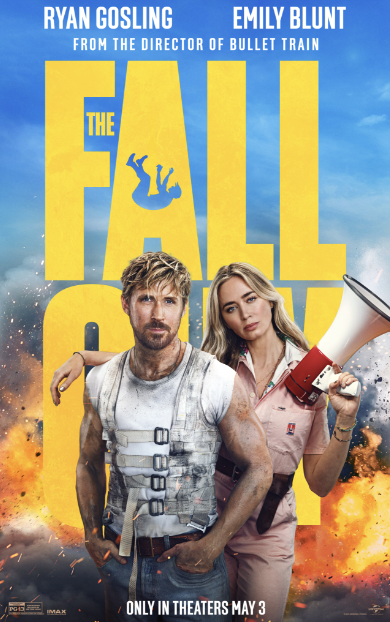Explosive fun! Universal Pictures The Fall Guy is one wild ride that connects with audiences! The thoughtful blend of self-referential humor and over-the-top, if not cheesy, action sequences work in tandem to entertain and thrill audiences. At the heart of this movie is a throwback-style romcom that is destined to warm even the most cynical of hearts. Moreover, this action-picked motion picture serves to spotlight the unsung heroes of many movies, the stunt performers, without whom we would not have the high stakes, death defying action sequences that we have today. And not just today, stunt performers have played a significant role in filmmaking since the beginning. The Fall Guy is a lively movie that whisks you off for the ride of your life that stumbles a little along the way, but sticks the landing.
After leaving the business one year earlier, battle-scarred stuntman Colt Seavers springs back into action when the star of a big studio movie suddenly disappears. As the mystery surrounding the missing actor deepens, Colt soon finds himself ensnared in a sinister plot that pushes him to the edge of a fall more dangerous than any stunt.
Such a crowd-pleasing cinematic spectacle! The summer blockbuster season is off to a strong start with this bombastic movie. Since I rarely watch trailers, I was unsure of what to expect, but I had a delightful time with this movie. The humor is mostly character-driven, but there are slapstick moments and almost camp-levels of action sequences that also serve as fuel for laughter. It’s a fun, popcorn flick that makes you laugh and smile all while being enthralled by the high-octane action. Some action movies that are devoid of humor or a romantic subplot can feel exhausting or shallow. Not the case with this one! This is both due to the strong writing and performative dimension.
More than an action/romcom, it also serves as a backstage movie, because of being set on a film set. And even more specifically, the technical achievement by camera operators, special effects technicians, and stunt performers. The movie spotlights the real danger that stunt performers face on set and the innate risks that come with this under-appreciated line of work. There is a human dimension to stunt work that so often goes overlooked, and The Fall Guy demonstrates the intrinsic value of stunt work and the real people that push their bodies to the limit to achieve action with dimension instead of simulated action in a computer.
The characters and the performances thereof elevate the entertainment value of the movie. Which is an important element because the screenplay does falter here and there from poor pacing. Some scenes are a little longer than they need to be while others are perhaps a little shorter than what they ought to be, which impacts the effectiveness of the exposition. But where the screenplay struggled, the cast makes up for the shortcomings! That’s not to say it’s a poorly written movie; quite the contrary, it’s mostly solidly written, just stumbles here and there. Emily Blunt and Ryan Gosling demonstrate excellent chemistry, and their relationship mountains and valleys feel genuine. They both share fantastic comedic and dramatic timing that crafts characters with dimension.
There is one particular line, that many may interpret as a throwaway or lacking in significant value, that I feel compelled to highlight. A character at a club states something to the effect of “movies try to be real, whilst cartoons know they aren’t real.” And the character prefers cartoons for that reason. This line was smartly written and delivers a important if not self-referential (or meta) message. Very little about The Fall Guy is supposed to feel real; it’s supposed to look like a fantasy set in the real world. What the movie is, is naturalistic. Everything happening in this film feels at home within the world of the movie. And yes, many, if not most, contemporary movies try so hard to not look fake or unbelievable. When movies should feel comfortable to take us to unbelievable heights to thrill us with entertaining, heart-warming, or scary stories. Being realistic is vastly overrated. There is a time and a place for it, but movies like The Fall Guy remind us of the value of a good story, regardless if it feels realistic in the real world.

Ryan teaches Film Studies and Screenwriting at the University of Tampa and is a member of the Critics Association of Central Florida and Indie Film Critics of America. If you like this article, check out the others and FOLLOW this blog! Interested in Ryan making a guest appearance on your podcast or contributing to your website? Send him a DM on Twitter. If you’re ever in Tampa or Orlando, feel free to catch a movie with him.





